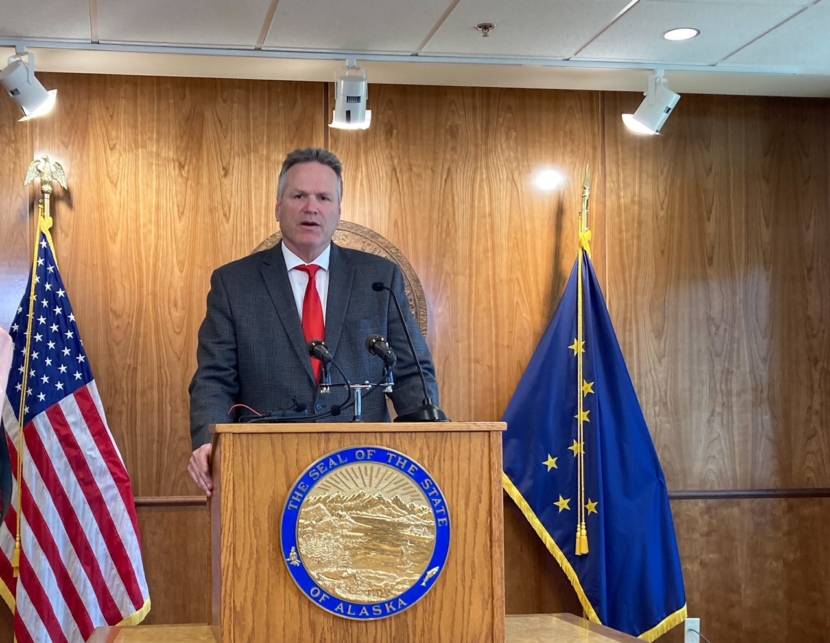
Gov. Mike Dunleavy announced on Thursday that he vetoed all remaining funding for permanent fund dividends in the state budget. He asked the Legislature to pass PFD funding during a special session scheduled to start on Aug. 2.
There was only enough money for $525 dividends before it reached Dunleavy’s desk. He said the dividend should follow a formula.
“We need to have a PFD that is going to follow a formula,” he said, describing the amount in the budget as “picked out of the air” and that Alaskans viewed it as “a joke.”
Dunleavy, a Republican, announced the veto as part of a larger list of line-item vetoes he announced a day after he signed the budget.
Dunleavy said Alaskans have asked him to fight for the PFD.
The budget bill would have paid for $1,100 PFDs, but there weren’t enough votes to pass a motion that most of the dividend money depended on.
House Speaker Louise Stutes, a Kodiak Republican, noted in a statement that most lawmakers voted for $1,100 dividends. She said that the PFD veto, as well as other vetoes, “creates uncertainty for families and individuals.”
She said the House majority caucus supports “the largest dividend we can afford.”
“We are also steadfast in our belief that we must protect the fund from overspending that mortgages our future by paying large dividends today,” she said.
Dunleavy repeated his call for the Legislature to pass major changes that he has proposed. They include adjusting the dividend formula and putting the dividend and protecting the permanent fund’s earnings reserve in the constitution. He also would reduce the state limit on spending and require a public vote to add a broad-based tax.
Nonpartisan analysts for the Legislature have estimated that without policy changes, the gap between what the state would spend under Dunleavy’s PFD proposal and what it would raise in revenue, would be roughly $1 billion annually over the next nine years. Dunleavy has not proposed changes to state policies to close that gap.
On Thursday, he said that shortly after the July 4th holiday, his administration would be publishing its own estimate of the long-term budget gap, which he said has “closed tremendously.”
He also vetoed a $4 billion transfer from the permanent fund’s earnings reserve to the fund’s constitutionally protected principal. Dunleavy said he wants protecting the money in the earnings reserve to be part of a broader plan for the permanent fund.
Dunleavy vetoed the daily payment to legislators that supplements their salaries and pays for living expenses during legislative sessions.
“We’ve got to get the permanent fund permanent,” he said. “It doesn’t make a lot of sense to be paying ourselves if we’re legislators, if we aren’t completing the task.”
In addition to the PFD veto, Dunleavy vetoed $206 million from the budget, which leaves $4.8 billion in the Legislature’s control.
The line-item vetoes include cutting money for more than $30 million in major maintenance projects at the three major university campuses; $38 million to grow and spend from a fund that pays for community assistance to municipal governments; and $17 million for rural school construction.
The Alaska Municipal League described the vetoes of money for community assistance, school constructions and ferries and harbors as “a step backward.”
Dunleavy said he wants to keep “downward pressure” on state spending. But he also said he didn’t want large cuts to existing programs.
“We’re in a fragile state,” he said. “It’s getting better. But we want to make sure our economy…our educational system, our businesses are growing stronger after the pandemic.”
Legislators who worked on the compromise budget have said there’s enough money for $1,100 PFDs this year without drawing more than planned from permanent fund earnings under a 2018 law.
But Dunleavy criticized a plan to reach the $1,100 PFD amount on Thursday.
“We shouldn’t have half-measures, half-approaches,” he said. “We shouldn’t be throwing crumbs at the people of Alaska.”
Nonpartisan budget analysts have estimated that without policy changes, the state could pay dividends of roughly $500 to $600 per year over the next decade without drawing more than planned from permanent fund earnings.
Dunleavy has proposed dividends of roughly $2,350 as part of his proposal to change the formula for setting PFDs, equal to half of the annual draw from the fund. This would require an additional $1.5 billion in spending this year. The full amount if the state followed the existing formula in state law would be roughly $3,700 — this would be equal to more than 77% of the draw and would require an additional $2.4 billion in annual spending.
This story has been updated with additional information about the vetoes and permanent fund dividends.
